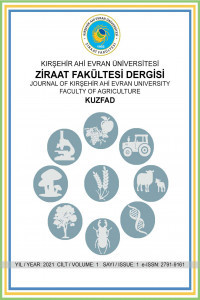Hypericum (Hypericaceae ) Türlerinin Depolanmış Ürün Zararlısı Ephestia kuehniella (Lepidoptera: Pyralidae) ve Parazitoit Trichogramma evanescens (Hymenoptera: Trichogrammatidae) Üzerine Fumigant Etkisi
Bu çalışmada önemli bir depo zararlısı olan Ephestia kuehniella Zeller 1879 (Lepidoptera: Pyralidae)
ve parazitoidi Trichogramma evanescens Westwood (Hymenoptera: Trichogrammatidae) üzerine halk
arasında kantaron olarak bilinen ve tıbbi aromatik bir bitki olan Hypericum spp. (Malpighiales:
Hypericaceae)’nin fumigant etkisi araştırılmıştır. Geleneksel yöntemle üretilmiş olan kantaron yağları
Silifke (A), Mersin (B), ve Elazığ (C) lokasyonlarından temin edilmiştir. Aynı zamanda yağ eldesinde
kullanılan bitki örneklerinin morfolojik teşhisi için ilgili yörelerden toplanan bitki örnekleri herbaryum
materyali şeklinde laboratuvara getirilmiştir. Morfolojik teşhis sonucu örneklerin H. perforatum (A ve
B) ve H. scrabum (C) olduğu tespit edilmiştir. Denemeler, E. kuehniella’nın yumurta, son dönem larva
ve erginleri üzerine, T. evanescens’in ise sadece ergin dönemine karşı yürütülmüştür. E. kuehniella’nın
son dönem larvalarının bütün yağ türlerine karşı en hassas evre olduğu tespit edilmiştir. Parazitoit
erginlerinin E. kuehniella erginlerine göre daha hassas olduğu gözlemlenmiştir. . En dayanıklı biyolojik
dönemi ise zararlının yumurta evresi olmuştur. Genel olarak tüm uygulamalarda ölüm oranının artan
doz ile birlikte artış gösterdiği belirlenmiştir. Sonuçlar uygulanan aromatik bitki türü yağlarının
depolama koşullarında depo zararlısına karşı fumigant potansiyeli olacağına işaret etmektedir
Anahtar Kelimeler:
Aromatik bitki, Hypericum spp., depo zararlısı, Ephestia kuehniella, parasitoit, Trichogramma evanescens, Aromatic plant, storage pest, parasitoid
Fumigant Effect of Hypericum (Hypericaceae) Species on Stored Product Pest Ephestia kuehniella (Lepidoptera: Pyralidae) and Parasitoid Trichogramma evanescens (Hymenoptera: Trichogrammatidae)
In this study, the fumigant effect of Hypericum spp. (Hypercaceae), a medicinal aromatic plant,
popularly known as St. John's Wort, on an important storage pest, Ephestia kuehniella Zeller
(Lepidoptera: Pyralidae) , and its parasitoid Trichogramma evanescens Westwood (Hymenoptera:
Trichogrammatidae) was investigated. St. John's Wort oils produced by the traditional method were
obtained from Silifke (A), Mersin (B), and Elazig (C) locations. At the same time, plant samples
collected from the relevant regions were brought to the laboratory in the form of herbarium material for
the morphological diagnosis of plant samples used in oil production. As a result of morphological
diagnosis, it was determined that the samples were H. perforatum (A and B) and H. scrabum (C). The
experiments were carried out on eggs, last larvae and adult stages of E. kuehniella, and only adult stage
of T. evanescens. It has been determined that the last stage larvae of E. kuehniella are the most sensitive
to all oil types. Parasitoid adults are also more sensitive than E. kuehniella adults. The most resistance
development stage was the egg stage of the pest. In general, it was determined that the mortality rate
increased with increasing dose in all applications. The results indicate that the applied aromatic plant
oils will have fumigant potential against this storage pest under storage conditions. Thus, sequential
application of parasitoid and essential oil will be effective to reduce the population density of the pest
under storage conditions.
Keywords:
Aromatik bitki, Hypericum spp., depo zararlısı, Ephestia kuehniella, parasitoit, Trichogramma evanescens, Aromatic plant, storage pest, parasitoid,
- Başlangıç: 2021
- Yayıncı: Kırşehir Ahi Evran Üniversitesi
